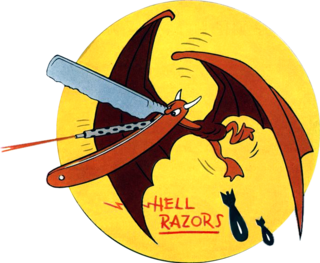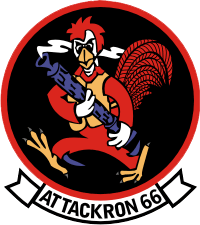
The Strike Fighter Squadron 14 (VFA-14) "Tophatters" are a United States Navy fighter attack squadron based at Naval Air Station Lemoore. They fly the F/A-18E Super Hornet, and are the Navy's oldest active squadron, having formed in 1919. Their callsign is Camelot, and their tail code is NG.

Strike Fighter Squadron 86 (VFA-86) is a strike fighter squadron of the United States Navy based at Naval Air Station Lemoore, California. The squadron is nicknamed Sidewinders, leading to the call sign Winder. The unit currently flies the F/A-18E Super Hornet and is assigned to Carrier Air Wing Seven, tail code AG.

Naval Air Station Oceana or NAS Oceana is a United States Navy Naval Air Station located in Virginia Beach, Virginia. The base is under the jurisdiction of Navy Region Mid-Atlantic and is the headquarters of Strike Fighter Wing Atlantic and Carrier Air Wings 1, 3, 7 and 8. As home to all east coast strike fighter jet squadrons, the Naval Air Station is classified as a master jet base. The airfield is known as Apollo Soucek Field, named after Lieutenant Apollo Soucek, a Navy Test Pilot who set the global altitude record in 1930 by flying a Curtiss "Hawk" biplane to an altitude of 43,166 feet.

Fighter Squadron Composite (VFC-13) Saints is a US Navy fighter squadron that provides adversary training for U.S. Navy air wings at NAS Fallon, Nevada. VFC-13 uses "Bogey" as its main radio callsign. Cmdr. Andrew Craig from Marion Ohio relieved Cmdr. Brandon "Buda" Harjer as Cmdr.

Fighter Squadron Composite Twelve (VFC-12) is a United States Navy Reserve fighter squadron based at NAS Oceana. It provides adversary training to East Coast Navy air wings. VFC-12 reports to Tactical Support Wing, a component of the Naval Air Reserve Force. The "Fighting Omars" are manned by selected reservists, full-time reservists (FTS) and active duty personnel.

Strike Fighter Squadron 81 (VFA-81), also known as the "Sunliners", is a United States Navy F/A-18E Super Hornet strike fighter squadron stationed at Naval Air Station Oceana. They are a part of Carrier Air Wing One, their radio callsign is Inferno, and their tail code is AB. Their mission is to conduct prompt and sustained combat operations from the sea. The squadron was originally designated VA-66 on 1 July 1955, was redesignated VF-81 the same day, redesignated VA-81 on 1 July 1959, and finally redesignated VFA-81 on 4 February 1988.

Strike Fighter Squadron 83 (VFA-83), also known as the "Rampagers", are a United States Navy F/A-18E Super Hornet fighter squadron stationed at Naval Air Station Oceana. They are a part of Carrier Air Wing 3, their tailcode is AC and their radio callsign is Ram.

Attack Squadron 174 (VA-174) also known as the "Hellrazors" was a United States Navy attack squadron based at Naval Air Station Cecil Field, Florida, and were attached to Light Attack Wing One. It was commissioned from 1944 to 1988.

Fighter Squadron Composite 111 (VFC-111) Sun Downers is a US Navy Reserve adversary squadron based at Naval Air Station Key West, Florida (USA). Currently, it operates Northrop F-5N/F Tiger-IIs, of most of which are single-seater F-5Ns and one twin-seater F-5F, the "FrankenTiger". The Squadron is composed of experienced active duty junior officers, full-time support reservists, and selective reserves. This gives the squadron cutting edge real-world experiences, as well as leveraging off experience and retaining talented instructors that have left active service.

Helicopter Sea Combat Squadron Nine (HSC-9) "Tridents" is a United States Navy helicopter squadron based at Naval Air Station Norfolk, Norfolk, Virginia. HSC-9 is attached to Carrier Air Wing Eight and deploys aboard USS Gerald R. Ford. HSC-9 was redesignated from HS-3 on 1 June 2009.

VA-106 was an Attack Squadron of the U.S. Navy. Originally established as Bomber-Fighter Squadron Seventeen (VBF-17) on 2 January 1945, it was redesignated Fighter Squadron Six B (VF-6B) on 15 November 1946, redesignated VF-62 on 28 July 1948, redesignated Attack Squadron 106 (VA-106) on 1 July 1955, it was disestablished on 7 November 1969. It was the second US Navy squadron to be designated VA-106.

VFA-203, nicknamed the Blue Dolphins, was a Strike Fighter Squadron of the U.S. Naval Reserve. It was established as Attack Squadron 203 (VA-203) flying the A-4 Skyhawk at NAS Jacksonville, Florida on 1 July 1970, as a reserve force squadron (RESFORON) under a new concept in the reorganization of the Naval Air Reserve Force. The reorganization was intended to make the reserves more compatible with active duty units and to increase their combat readiness. It was deactivated on 30 June 2004.

VA-36, nicknamed the Roadrunners, was an Attack Squadron of the U.S. Navy. It was established as Fighter Squadron VF-102 on 1 May 1952, redesignated VA-36 on 1 July 1955, and disestablished on 1 August 1970. It was the first squadron to be designated VA-36, the second VA-36 was established on 6 March 1987 and disestablished on 1 April 1994.

VA-66 was an Attack Squadron of the U.S. Navy; it was the second squadron to be so named. The squadron was called to duty and established as Reserve Fighter Squadron VF-671 on 1 February 1951. It was redesignated Fighter Squadron VF-81 on 4 February 1953, and finally as VA-66 on 1 July 1955. The squadron was disestablished on 1 October 1986, but one detachment continued in existence until 31 March 1987. The squadron's nickname was the Waldomen from the 1950s to the early 1960s, and the Waldos from that point forward. Its insignia, a rooster toting a machine gun, was a well-known design in naval aviation.

VA-34, nicknamed the Blue Blasters, was an Attack Squadron of the U.S. Navy. The squadron was established as Fighter Squadron VF-20 on 15 October 1943, redesignated as VF-9A on 15 November 1946, as VF-91 on 12 August 1948, and as VF-34 on 15 February 1950. It was finally redesignated VA-34 on 1 July 1955. The squadron was disestablished on 1 June 1969. It was the second squadron to bear the VA-34 designation, the first one having been renamed VA-35 in 1950.

VA-44, nicknamed the Hornets, was an Attack Squadron of the US Navy. The squadron was established as Fighter Squadron VF-44 on 1 September 1950, and redesignated VA-44 on 1 January 1956. It was disestablished on 1 May 1970. It was the second squadron to be designated VA-44, the first VA-44 was disestablished on 8 June 1950.

Attack Squadron TWELVE, also known as the "Flying Ubangis" or "Clinchers", was an attack squadron of the United States Navy active during the Cold War. From their home port at Naval Air Station Cecil Field in Florida, the squadron made more than thirty major overseas deployments aboard aircraft carriers, primarily flying A-4 Skyhawk and later the A-7E Corsair II, including two combat tours in the Vietnam War.
VF-43 was a Fighter Squadron of the U.S. Navy. The squadron was originally established as Fighter Squadron 74A (VF-74A) on 1 May 1945, it was redesignated Fighter Squadron 74 (VF-74) on 1 August 1945, redesignated VF-1B on 15 November 1946, redesignated VF-21 on 1 September 1948, redesignated as Attack Squadron 43 (VA-43)Challengers on 1 July 1959 and Fighter Squadron 43 (VF-43) on 1 June 1973. It was disestablished on 1 July 1994.

Fighter Squadron 111 (VF-111), also known as the Sundowners, was a fighter squadron of the United States Navy. Originally established as Attack Squadron 156 (VA-156) on 4 June 1955, it was redesignated VF-111 on 20 January 1959, the day after the original VF-111 was disestablished. The squadron was redesignated VF-26 on 1 September 1964, redesignated as VF-111 on 17 September 1964 and disestablished on 31 March 1995.



















